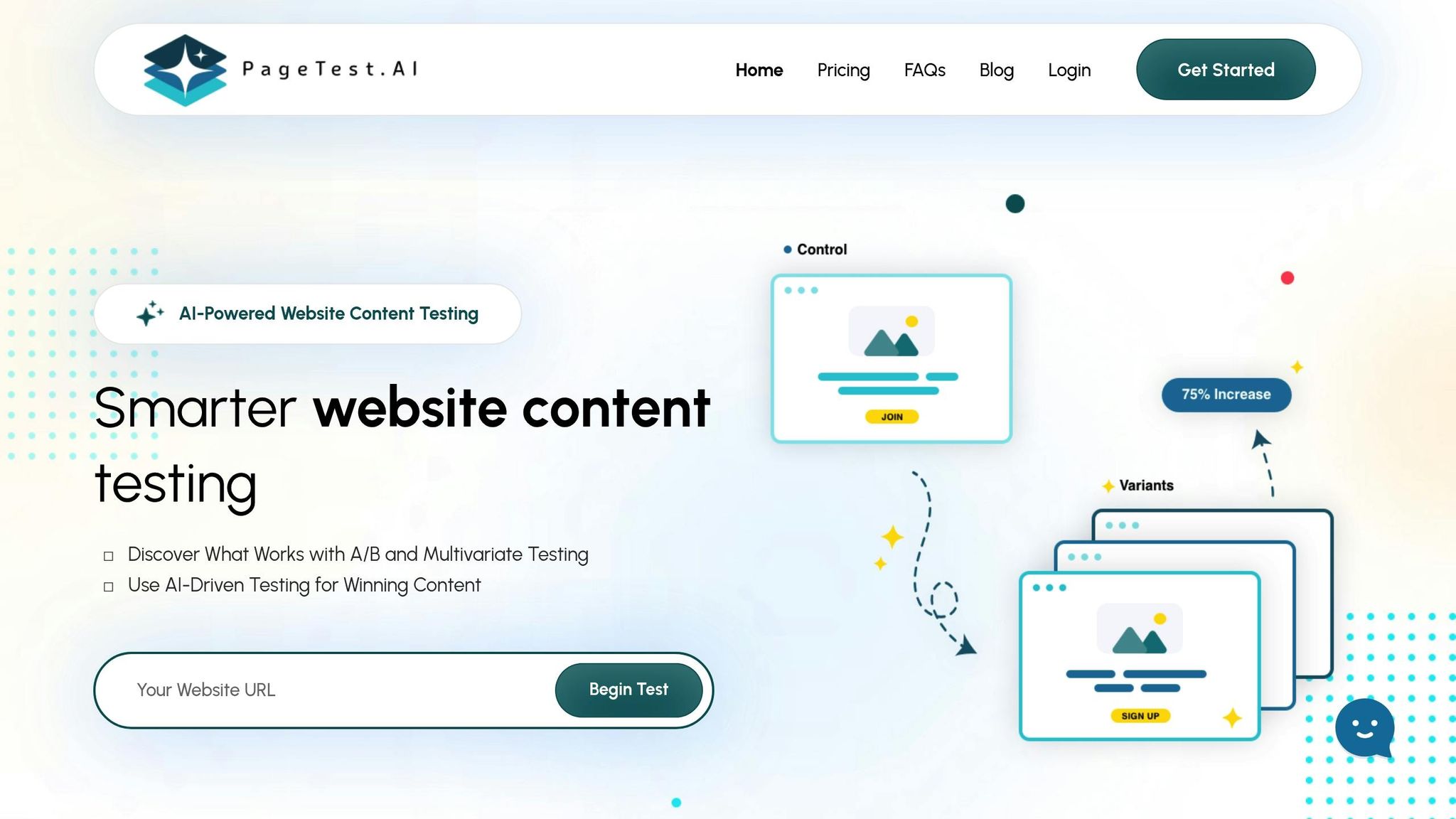

How Multivariate Testing Fails Without Proper Planning

How Multivariate Testing Fails Without Proper Planning
 10-11-2025 (Last modified: 10-11-2025)
10-11-2025 (Last modified: 10-11-2025)
- Set Clear Goals: Define specific, measurable objectives tied to business outcomes (e.g., "increase email sign-ups by 10%").
- Prioritize High-Impact Variables: Focus on elements like headlines, CTAs, and hero images instead of minor tweaks.
- Ensure Sufficient Data: Calculate proper sample sizes and let tests run long enough to achieve reliable results.
Failing to address these areas can result in inconclusive data or even harm conversion rates. On the other hand, structured planning helps businesses achieve up to a 30% boost in conversion rates. Tools like PageTest.AI simplify the process by automating content creation, tracking metrics, and calculating sample sizes in real time.
The key takeaway? Proper planning is the foundation of successful multivariate testing. Start with clear goals, test meaningful variables, and ensure you have enough data to make informed decisions.
Mistakes you will find in AB testing everywhere | Experiment pitfalls
Common Problems with Poor Multivariate Testing Planning
Getting multivariate testing right starts with solid planning. Without it, you risk unclear goals, an overload of variables, and unreliable data. These issues often lead to wasted effort and inconclusive results.
Vague Testing Goals and Objectives
One of the biggest missteps in multivariate testing is diving in without clear, measurable goals. For example, saying "improve the homepage" is far too broad. Instead, you need specific targets like "increase email sign-ups by 10%" or "boost checkout completion rates by 15%."
Why does this matter? Vague goals make it nearly impossible to evaluate your results objectively. Without precise objectives, the analysis becomes guesswork, and your efforts won’t translate into actionable insights.
The fix is simple: define success before starting the test. Tie each goal directly to a measurable business outcome, such as conversions or revenue growth. This ensures your test results lead to meaningful improvements that align with your broader business strategy.
Testing Too Many Variables at Once
Another common pitfall is testing too many variables simultaneously. While it might seem efficient to test everything at once, this approach can quickly spiral into chaos.
Here’s why: each additional variable exponentially increases the number of combinations you need to test. Before you know it, you’re dealing with hundreds – or even thousands – of variations. This creates two major challenges: you’ll need enormous amounts of traffic to get reliable results, and pinpointing which specific changes drove improvements becomes nearly impossible.
Take a lesson from an Optimizely case study. An e-commerce company initially tested too many elements on their checkout page at once. The result? Inconclusive data. But when they narrowed their focus to a few high-impact variables and ensured they had enough traffic, they saw a 15% jump in sales.
The takeaway? Focus on testing elements that matter most, like headlines, calls-to-action, or hero images. Avoid wasting resources on low-impact areas, such as footer text or minor design tweaks. This targeted approach simplifies analysis and increases your chances of finding meaningful results.
Insufficient Sample Sizes and Statistical Problems
The third major issue is failing to calculate proper sample sizes or ending tests too early. Teams often get excited by early results and rush to implement changes. Or they underestimate the traffic needed to test multiple combinations effectively.
Here’s the problem: insufficient data leads to unreliable conclusions. You might think you’ve identified a winning variation, but the results could just be a fluke. This opens the door to Type I errors – implementing changes that don’t actually improve performance.
Multivariate testing has more demanding statistical requirements than simple A/B tests. Each combination needs enough traffic to reach statistical significance. Without this, you could run a test for weeks only to find the results can’t be trusted.
Ending tests prematurely only makes things worse. Early results might look promising, but they often don’t account for normal user behavior fluctuations or seasonal trends. Patience is key. Letting tests run their full course ensures your findings are reliable.
Thankfully, modern testing platforms can calculate the required sample sizes for you and monitor statistical significance in real-time. This takes the guesswork out of knowing when you’ve gathered enough data to make informed decisions.
These three challenges – unclear goals, testing too many variables, and insufficient sample sizes – are deeply connected. Vague objectives make it harder to decide what to test. Testing too many variables increases the traffic you’ll need. And without enough traffic, even well-defined goals can lead to unreliable results. The solution? Start with clear, measurable goals and plan your tests carefully from the outset. This foundational work will save you time and ensure your efforts yield actionable insights.
How to Set Clear Goals and Hypotheses
Building a strong testing strategy starts with defining clear goals and testable hypotheses. These are the cornerstones of effective experimentation, shaping what you test, how you measure success, and how results impact your business.
Connecting Goals to Business Objectives
Every multivariate test should align with your business’s top priorities – whether that’s driving revenue, retaining customers, or increasing lead generation. When your testing efforts connect directly to these objectives, the results become more actionable and valuable.
Start by identifying your company’s key performance indicators (KPIs). For example, if your goal is to boost online sales by 20% this quarter, your testing might focus on optimizing product pages to improve conversion rates. If lead generation is the priority, you could experiment with different headline and call-to-action (CTA) combinations on landing pages to grow email sign-ups.
Here’s a practical example: An e-commerce company aimed to increase their average order value (AOV) from $75 to $85. Instead of randomly testing page elements, they zeroed in on product recommendation sections and promotional messaging. They tested various combinations of "You might also like" placements, discount banners, and bundled offers – all directly tied to their AOV goal.
The secret here is being specific. Don’t settle for vague goals like "improve the checkout experience." Instead, define success clearly: "reduce cart abandonment by 12%" or "increase checkout completion rates from 68% to 75%." This level of detail helps you focus on the right elements to test and makes it easier to determine if your efforts are paying off.
Structured testing delivers results. Research shows that businesses using hypothesis-driven experimentation see an average 30% improvement in conversion rates compared to those testing without clear objectives.
Once your goals are aligned with business objectives, the next step is to craft precise, measurable hypotheses to guide your tests.
Creating Testable Hypotheses
A strong hypothesis serves as the blueprint for your test. It should be specific, measurable, and actionable, clearly outlining what you expect to happen when you make certain changes.
Here’s a comparison of a weak and strong hypothesis:
- Weak hypothesis: "Changing the homepage will improve conversions."
- Strong hypothesis: "Changing the headline to ‘Free Shipping on All Orders Over $50’ and the CTA to ‘Shop Now’ will increase conversion rates by 8% within three weeks."
The strong hypothesis leaves no room for ambiguity. It identifies the exact changes, predicts the outcome, and sets a timeframe for evaluation. This clarity ensures you can measure success accurately.
When designing hypotheses for multivariate tests, focus on high-impact elements that influence user behavior. These include headlines, CTAs, product images, and promotional offers – components that directly affect conversions. Avoid spending time on minor tweaks like footer text or background colors, as these rarely produce meaningful results.
It’s also crucial to define which metrics you’ll track. Are you measuring conversion rates, click-through rates, time on page, or average order value? Choose metrics that align with your goals and can be consistently tracked throughout the test.
Tools like PageTest.AI can simplify the process by generating content variations and tracking performance metrics automatically. This allows your team to focus on crafting strong hypotheses and analyzing results, rather than getting bogged down in technical details.
Finally, remember that even if your hypothesis doesn’t yield the expected outcome, it’s still a valuable learning experience. A well-structured hypothesis helps you understand why certain changes didn’t work and guides future testing strategies. Documenting your hypotheses and results builds a knowledge base that can inform and improve future optimization efforts over time.
Choosing Variables That Affect Conversion Rates
Selecting the right variables can make or break your testing efforts. The difference between a successful optimization campaign and wasted resources often lies in focusing on elements that genuinely influence user behavior. Testing the wrong variables isn’t just inefficient – it’s expensive and yields little actionable data.
To get meaningful results, prioritize elements that directly impact user decisions. Concentrate on features like headlines and CTAs, as they drive immediate actions. This targeted approach ensures your testing efforts are both strategic and effective.
Targeting High-Impact Page Elements
When it comes to multivariate testing, some page elements carry far more weight than others. Key areas to focus on include headlines, call-to-action (CTA) buttons, and product descriptions.
- Headlines: These grab attention and communicate your value proposition in just seconds. A strong headline can hook users and boost engagement, while a weak one may drive them away.
- CTA Buttons: These are the tipping point for conversions. The text, color, size, and placement of your CTA buttons all play a role in whether users take action.
- Product Descriptions and Images: These provide the details users need to make informed decisions. When optimized, they can address common concerns, build trust, and increase confidence in your offering.
"Love this product, it means we get the most from our site’s traffic. Knowing we can test every call to action and optimize our SEO efforts is very satisfying." – David Hall, CEO | AppInstitute
Other critical elements include form fields and pricing displays. The number and layout of form fields can significantly affect completion rates, while pricing presentation – including discounts and payment options – directly impacts purchasing decisions.
Analytics can guide you in pinpointing which elements to test first. For example, heatmaps show where users focus their attention, while user behavior studies highlight areas of confusion or drop-offs. A 2023 Optimizely case study illustrated this perfectly: an e-commerce company achieved a 15% sales boost by focusing its tests on checkout page elements like button text and form layout.
Platforms like PageTest.AI simplify this process by generating AI-driven variations for high-impact elements such as headlines, CTAs, and product descriptions. By narrowing your focus to these areas, you can avoid wasting time on changes that won’t move the needle.
Avoiding Low-Impact or Irrelevant Variables
While it’s tempting to test every possible variable, including low-impact elements can dilute your results and unnecessarily complicate your tests. For example, footer text, minor color tweaks in less prominent areas, or secondary navigation links rarely influence conversions enough to justify the effort.
Adding too many variables increases the number of combinations, requiring more data to achieve statistical significance. Before including a variable, ask yourself: “Will changing this likely affect whether someone converts?” If the answer is no, leave it out.
It’s also important to avoid creating confusing or contradictory combinations. For example, testing multiple discount offers at once can lead to conflicting messages, while mixing aggressive and subtle CTA language might result in incoherent variations. Use your testing platform’s preview feature to review all possible combinations before launching to ensure a seamless user experience.
Companies that take a structured approach to variable selection often see conversion rate improvements of 30%, compared to those that test randomly. Tools like PageTest.AI can help by focusing on proven high-impact variables and tracking key metrics like clicks, engagement, and user behavior patterns. Additionally, removing underperforming variations mid-test allows you to allocate more traffic to promising options.
sbb-itb-6e49fcd
Getting Adequate Sample Sizes and Test Durations
When it comes to multivariate testing, ensuring statistical validity is non-negotiable. Without enough data and sufficient test duration, even the most carefully designed experiments can lead you astray. Unlike A/B testing, where traffic is split between just two options, multivariate testing divides your visitors among multiple combinations. This means you’ll need more traffic and time to reach reliable results.
Nailing this process can save you from wasting resources and help you uncover actionable insights. In fact, companies that calculate proper sample sizes before testing have reported, on average, a 30% boost in conversion rates. Getting these basics right is key to avoiding costly mistakes caused by incomplete data.
Calculating Required Sample Sizes
Figuring out the right sample size hinges on a few factors: your current conversion rate, the minimum change you’re aiming to detect, and the number of combinations you’re testing. The more variables and combinations you include, the larger your sample size needs to be to maintain statistical reliability.
For example, let’s say you’re running a test on an e-commerce site with a 4% conversion rate. You decide to test three headlines and two CTA button colors – six combinations in total. To detect a 1% improvement (from 4% to 5%) with 95% confidence, you’d need about 2,000 visitors per combination, or roughly 12,000 visitors altogether.
As you increase the complexity of your tests – like moving to three elements with three variations each, resulting in 27 combinations – the traffic and time required grow exponentially. This is why it’s crucial to focus on high-impact variables. Every additional combination spreads your traffic thinner and stretches your timeline.
To plan effectively, use traffic estimators and sample size calculators. Many testing platforms come with built-in tools, or you can find online calculators tailored to your specific conversion rates and traffic patterns. Tools like PageTest.AI even automate much of this process, tracking real-time performance and advising when you’ve reached statistical significance.
For websites with lower traffic, consider simplifying your tests by limiting variables or using fractional factorial designs. This approach tests only a subset of possible combinations, which may not give you the full picture but ensures each variation gets enough visitors for reliable conclusions.
Once you’ve nailed down your sample size, the next step is determining how long your test should run.
Setting Optimal Test Durations
After calculating the required sample size, it’s time to figure out how long your test needs to run. The goal is to allow enough time for dependable results without dragging things out unnecessarily.
Start by dividing your required sample size by your average daily traffic. For instance, if you need 12,000 visitors and your site gets 1,000 daily, plan for at least 12 days. Add a few extra days to account for variations in weekday versus weekend traffic, seasonal shifts, or promotional events.
Keep an eye on performance during the test. If certain combinations clearly underperform early on, you can remove them to redirect traffic to more promising variations. This can speed up your test without sacrificing statistical validity. For example, if one variation is significantly lagging after a smaller sample is reached, cutting it out allows you to concentrate on the stronger contenders.
In 2023, an e-commerce company showcased the value of this disciplined approach. By testing their checkout page over six weeks with 120,000 visitors, they waited until all combinations met the necessary sample size. The result? A statistically significant 15% increase in sales.
It’s essential to avoid ending tests too soon due to random fluctuations. On the flip side, running them for too long can delay actionable changes. Set clear criteria before starting: once you hit your calculated sample size and see consistent results over the planned duration, you can confidently move forward with the winning variation.
Tools like PageTest.AI make this process easier by automatically dividing traffic among variations and notifying you when statistical significance is reached. This eliminates much of the guesswork, ensuring your tests are both efficient and effective – no advanced statistical knowledge required.
Using PageTest.AI for Better Multivariate Testing

Planning effectively is key to successful multivariate testing, and having the right tools makes all the difference. PageTest.AI simplifies the process, tackling common challenges that often derail tests. From generating content to analyzing performance, it streamlines every step, helping you zero in on the combinations that drive conversions.
What sets this platform apart is how it eliminates roadblocks. Instead of wrestling with complicated setups or spending weeks crafting variations manually, you can focus on what truly matters: finding the best-performing combinations to boost conversions. It bridges the gap between solid planning and meaningful, actionable results.
AI-Generated Content Variations
PageTest.AI takes the hassle out of creating multiple test variations. It automatically generates optimized versions of headlines, CTAs, button texts, and product descriptions. This means you can skip the manual work and test a broader range of options much faster.
"Let AI do all the heavy lifting for you. Take the effort out of content production for your tests."
– PageTest.AI
By automating content creation, the platform addresses a common issue: testing too few variations. When the process becomes quick and effortless, you’re more inclined to experiment with diverse options, uncovering meaningful improvements. What once took days or weeks can now be done in minutes, allowing for faster launches and more frequent iterations.
Tracking Performance Metrics Automatically
Tracking performance manually is often where multivariate tests hit a snag. PageTest.AI solves this with an automated monitoring system that tracks key metrics like clicks, engagement rates, time on page, and scroll depth – all in real time. This ensures you have reliable data to guide decisions without needing manual input.
The platform doesn’t just track; it also analyzes. It identifies underperforming variations early, suggesting their removal so traffic can be directed to stronger options. This approach helps you achieve statistically sound results faster, without compromising on data quality.
"No more guesswork. No manual coding. Just data-backed decisions that help you convert more visitors into customers."
– PageTest.AI
For teams that have struggled with incomplete data or analysis paralysis, this system offers a much-needed upgrade in efficiency and accuracy.
No-Code Setup for Easy Testing
PageTest.AI’s no-code setup makes launching tests incredibly simple. Using a Chrome extension, you can highlight any webpage element – whether it’s a headline, CTA, or product description – and the platform takes care of the rest. It integrates seamlessly with popular website builders like WordPress, Wix, Shopify, and Magento, requiring just a snippet to get started.
"Optimizing your website has never been easier. With PageTest.AI, you can launch powerful A/B and multivariate tests in just a few clicks – no coding required."
– PageTest.AI
This user-friendly approach is a game changer for small businesses or marketing teams without technical resources. Instead of waiting weeks for a developer or outsourcing the task, you can set up tests the same day. Many users have reported launching their first test within minutes of signing up, a stark contrast to platforms that require extensive training and technical expertise.
"As someone who has founded several online businesses, this tool is heaven sent! I’ve been looking for a cost-efficient way to test my web page content for years. Since Google shuttered Optimize, there really has been no good alternative. Great job guys."
– Yaro Siryk, cofounder | 3way.Social
With its blend of AI-powered content creation, automated performance tracking, and a no-code setup, PageTest.AI makes testing and optimization accessible to everyone. By handling the technical details and data collection, the platform allows you to focus on what matters most: setting clear goals and testing the variables that will have the biggest impact.
Conclusion: Planning Makes Multivariate Testing Work
The success or failure of multivariate testing hinges on one key factor: a solid plan. Without it, even the most advanced tools can waste time and resources.
Good planning doesn’t just guide your tests – it drives results. On average, companies that approach multivariate testing with structure see a 30% boost in conversion rates. That’s a significant payoff for doing it right.
Jumping into testing without a plan can quickly spiral out of control. Testing too many variables at once creates an overwhelming number of combinations, which can stretch your traffic thin and make it tough to achieve statistical significance.
The solution? Choose your variables strategically. Focus on elements that truly affect user behavior, like headlines, CTAs, or hero images. Avoid wasting time on tweaks that don’t move the needle. This way, you’re directing your efforts where they’ll make the biggest difference.
Planning also brings accountability to the process. When you set clear, measurable goals upfront, every test variation serves a purpose. Each one is tied to answering critical business questions and driving growth. This clarity keeps your team focused and ensures the insights you gain are actionable.
With a strong plan in place, you can trust your data and confidently implement winning variations. On the other hand, poorly planned tests often lead to indecision and missed opportunities. Thoughtful experiments don’t just deliver immediate results – they also build a knowledge base about what resonates with your audience. Over time, this fuels a cycle of continuous improvement, turning your website into a conversion powerhouse.
FAQs
What should you focus on when setting goals for multivariate testing to get reliable results?
To get dependable outcomes from multivariate testing, you need to establish specific, measurable goals right from the start. Pinpoint exactly what you’re aiming to improve – whether it’s click-through rates, conversions, or user engagement. Then, outline the variables you’ll test, such as headlines, call-to-action (CTA) text, or button colors. It’s also crucial to ensure your sample size is large enough to yield statistically reliable results.
Tools like PageTest.AI can make this process much easier. They offer AI-generated content variations and track key performance metrics, enabling you to make smarter, data-backed decisions.
How can businesses choose the right number of variables for multivariate testing without complicating their analysis?
To figure out the right number of variables for multivariate testing, start by defining your testing goals. Pinpoint the elements that have the biggest influence on user behavior – things like headlines, call-to-action (CTA) buttons, or the text on your buttons. Testing too many variables at once can make your analysis messy and less effective, so it’s better to focus on a few key areas rather than trying to test everything at once.
Make sure your sample size is large enough to handle the complexity of your test. A bigger sample size ensures your results are statistically reliable, especially when testing multiple variables. Tools like PageTest.AI can make this process smoother by generating AI-powered content variations and tracking how they perform. This way, you can manage and analyze your tests without the headache.
How can I ensure accurate test durations and sufficient sample sizes for successful multivariate testing?
To get trustworthy results from multivariate testing, careful planning around sample sizes and test durations is key. Begin by setting clear objectives – identify exactly what you’re measuring and how you’ll define success. Tools like statistical calculators can help you estimate the sample size you’ll need, factoring in your website’s traffic and anticipated conversion rates.
It’s also crucial to let your test run long enough to reflect variations in user behavior, such as differences between weekdays and weekends. A good guideline is to run the test for at least a full business cycle (typically 7 days) to capture a range of audience behaviors. Thoughtful preparation like this minimizes errors and ensures you can make informed, data-driven decisions.
Related Blog Posts
say hello to easy Content Testing
try PageTest.AI tool for free
Start making the most of your websites traffic and optimize your content and CTAs.
Related Posts

 08-11-2025
08-11-2025
 Ian Naylor
Ian Naylor
AI in Behavioral Segmentation: 3 Success Stories
Explore how AI-driven behavioral segmentation is reshaping customer engagement, with success stories from various industries showcasing measurable results.

 06-11-2025
06-11-2025
 Ian Naylor
Ian Naylor
How Predictive Segmentation Improves Conversions
Learn how predictive segmentation can significantly enhance conversion rates and optimize marketing strategies through data-driven insights.

 04-11-2025
04-11-2025
 Ian Naylor
Ian Naylor
How AI Improves Multilingual QA
Explore how AI enhances multilingual quality assurance, improving accuracy, speed, and cost-efficiency in translation processes.
